Woodcut and Cordel Literature: The Art and Popular Tradition of the Northeast
In the Northeast of Brazil, both cordel literature and woodcut play significant cultural roles and are deeply rooted in regional traditions.
This symbiotic relationship between woodcut and cordel literature not only beautifies the pamphlets but also amplifies the cultural and educational impact of the stories narrated.
1. Woodcut
While the cordel texts provide content and narrative, the woodcuts offer a visual interpretation that makes the content more accessible and appealing to the audience.
Together, these forms of expression preserve and transmit the traditions and stories of the region, playing a vital role in maintaining the cultural identity of the Northeast and celebrating popular creativity.
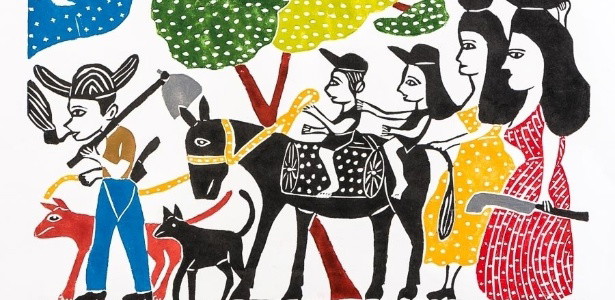

Video about Woodcut


Xilogravura - como se faz?

Xilogravura - Literatura de Cordel05:14
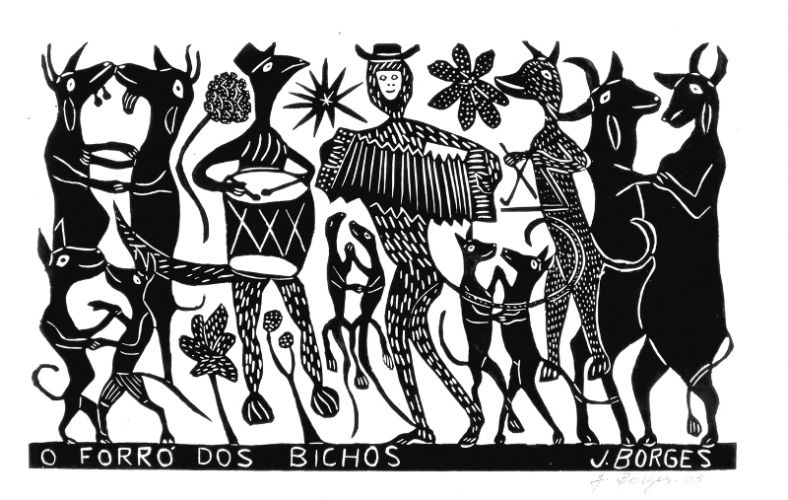
Xilogravura - Cordel07:40
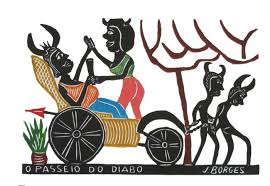
Xilogravura - Ferramentas13:26
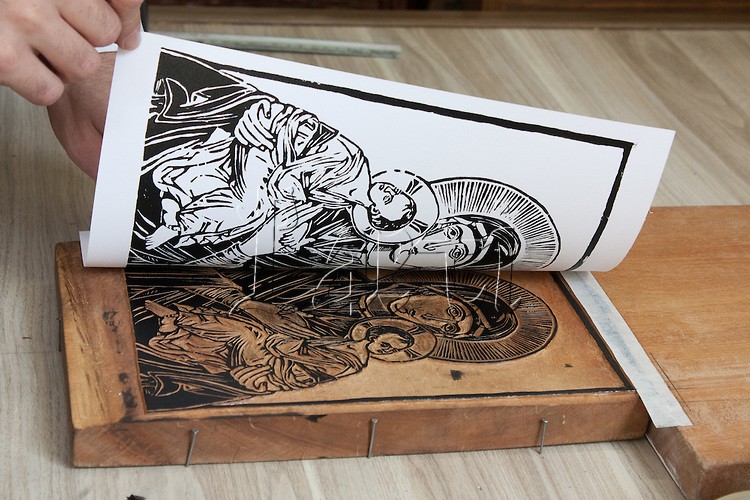
Impressão em xilogravura na madeira
Let’s explore how these two forms of artistic expression intertwine and influence Northeastern culture:
2. Cordel Literature
Origin and Development
Cordel literature has its roots in the popular traditions of the Northeast, being a genre that combines poetry, narrative, and visual elements. Its origin can be traced back to various historical and cultural factors:
- Cultural Influences: Cordel literature is the result of the fusion of European, African, and indigenous influences. The troubadour poets, who composed rhymes and songs in the Iberian Peninsula, along with African and indigenous oral traditions, contributed to the formation of this literary genre.
- Arrival of Immigrants: Cordel literature began to take a more consistent structure in Brazil during the 19th century, when immigrants, mainly Portuguese, brought the tradition of pamphlets that were sold at fairs and markets. These pamphlets, which often featured stories of heroes, legends, and historical events, were adapted to the local context.
- Popularization: From the 19th century onwards, cordel literature became popular in Northeastern fairs, where cordelists (poets) sold their pamphlets hanging from strings, hence the name “cordel.” This made literature an accessible form of cultural expression for local populations, who identified with the stories told.
- Press and Woodcut: The introduction of the printing press and the technique of woodcut were also crucial for the dissemination of cordel literature. The woodcuts illustrated the pamphlets, making them more attractive and helping to narrate the stories visually.
- Themes: The themes addressed in cordel literature range from love stories, adventures, and legends to social critiques, historical events, and everyday issues, reflecting the culture and reality of the Northeastern population.
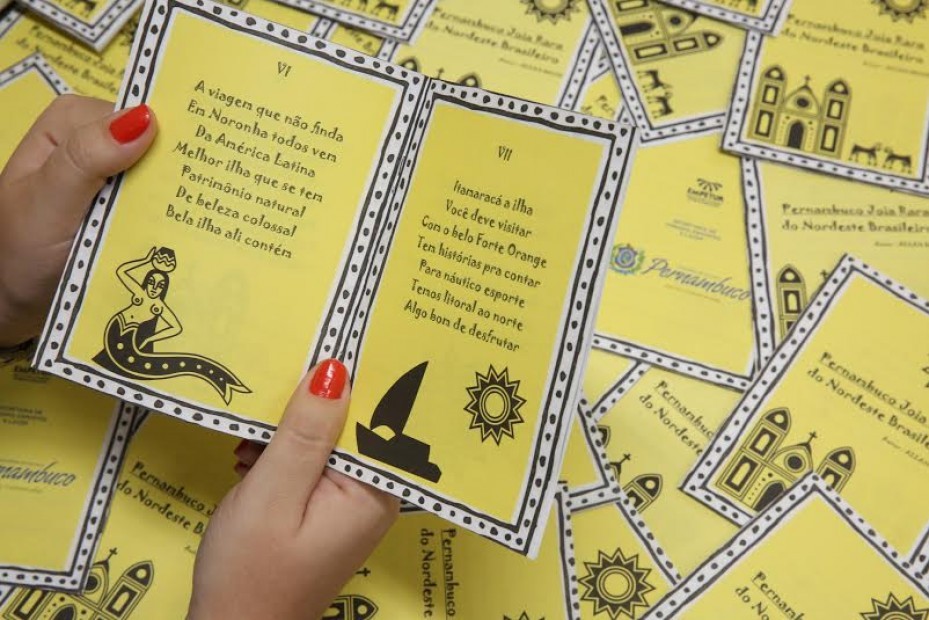
Characteristics
Written in rhymed and metrical verses, cordel literature is known for its narratives about heroism, legends, historical events, and social issues.
The texts are often printed in pamphlets, hung from strings (hence the name “cordel”) and sold at fairs and markets.
Themes
The themes covered include romances and adventures to social critiques and accounts of local events. It is an accessible way to disseminate information and popular culture.
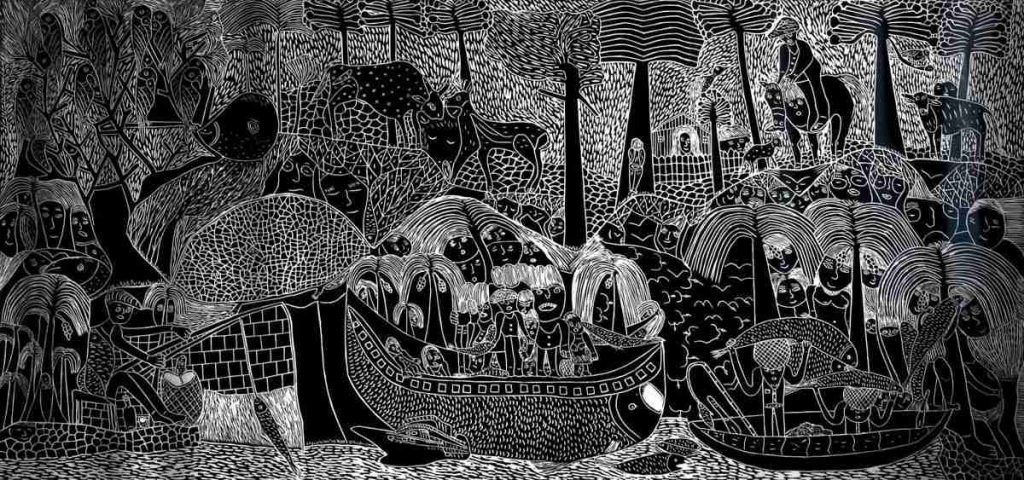
Examples of Works
Several notable works in cordel literature and woodcut are recognized for their relevance and cultural impact:
- “The Romance of Lampião and Maria Bonita”: Written by Leandro Gomes de Barros, this cordel narrates the famous story of the bandit Lampião and his companion Maria Bonita. It is a classic example of how cordel literature addresses figures from Northeastern folklore.
- “The Arrival of the Prostitute in Heaven”: This work by J. Borges is a famous woodcut that, in addition to being an illustration, offers a social critique and reflection on morality and society.
- “The Story of the King of Cattle”: Another cordel by Leandro Gomes de Barros, which tells the saga of a king who became a powerful farmer, reflecting the realities of the Northeastern hinterland.
- “The Thief of Baghdad”: This work is an example of adapting universal stories to the cordel format, showcasing the versatility of the genre.
- “The Adventures of João Grilo”: Written by Ariano Suassuna, this work is an adaptation for cordel of the stories of the popular character João Grilo, an anti-hero who uses cleverness to succeed in various situations.
- “The Hammer of God”: A work by Zé da Luz, depicting the struggle of the Northeastern people against the adversities of drought and the quest for justice.
These examples demonstrate the richness and diversity of cordel literature and woodcut, reflecting Northeastern culture and identity.
3. Introduction of Woodcut in Brazil
Origin and Development
Woodcut arrived in Brazil with Portuguese colonizers and was adapted by Northeastern artists to illustrate cordel literature. This engraving technique is widely used to create illustrations that accompany the verses of cordel pamphlets.
Characteristics
It involves carving images on a wooden block, which is then inked and printed on paper. Woodcuts are recognized for their distinctive graphic style and often detailed and expressive images.
Themes
The illustrations often depict scenes from the cordel texts, such as folkloric figures, battles, and historical events, along with decorative elements that beautify the pamphlets.
Relationship and Impact in the Northeast
Cultural Integration
Cordel literature and woodcut are inseparable in the Northeastern context. Cordel pamphlets often use woodcuts to illustrate and enrich the texts, creating a combined art form that reflects the rich cultural tradition of the region.
Preservation of Traditions
Both forms of expression are fundamental in preserving and transmitting Northeastern popular culture. They document stories, myths, and aspects of everyday life that could be lost without these records.
Education and Entertainment
They serve as a means of education and entertainment for the local population, offering an accessible way to learn about the history, culture, and social issues of the region.
4. Importance of Woodcut in Cordel Literature
Woodcut plays a fundamental role in cordel literature, contributing in various ways to its richness and cultural impact:
- Visual Interpretation: Woodcuts provide a visual interpretation of the stories told in the cordéis, making them more accessible and appealing to the audience. They help illustrate the plots and characters, enriching the reader’s experience.
- Beautification of Pamphlets: The art of woodcut beautifies the cordel pamphlets, making them more inviting and stimulating audience interest. The eye-catching illustrations attract attention and encourage reading.
- Cultural Preservation: Woodcut helps preserve and transmit Northeastern popular culture, documenting myths, legends, and aspects of everyday life. These illustrations often depict elements of local culture, contributing to the maintenance of regional identity.
- Education and Awareness: Woodcuts not only beautify but also inform. They can illustrate social, historical, and cultural issues, serving as educational tools that spark curiosity and interest in learning about Northeastern culture.
- Artistic Expression: The combination of woodcut and cordel literature represents a unique form of artistic expression, where visual art and literature intertwine. This enriches the artistic tradition of the region, promoting popular creativity.
- Support for Authors: Many cordelists, like J. Borges, are also woodcut artists. This duality allows authors to have full control over the presentation of their works, contributing to the originality and authenticity of the pamphlets.
- Promotion of Orality: Woodcut complements the oral tradition of cordel literature, helping to tell stories that are often passed down from generation to generation. The images help fix these narratives in the collective memory.
Examples and Impact
Famous Artists
Prominent artists in Northeastern woodcut include the renowned woodcut artist and cordelist J. Borges, whose work is widely recognized for its technical skill and aesthetic innovation.
Cultural Events
Major cultural events that celebrate woodcut and cordel literature in the Northeast are vital for the promotion and preservation of these traditions. Some of the most notable events include:
- International Literary Festival of Paraty (FLIP): Although not exclusively Northeastern, FLIP includes discussions and celebrations about cordel literature and woodcut, bringing together artists, writers, and literature enthusiasts.
- Winter Festival of Garanhuns: Held in Garanhuns, Pernambuco, this festival promotes various cultural manifestations, including performances by cordelists and exhibitions of woodcuts.
- Cordel Fair of Caruaru: Caruaru, one of the most traditional cities in the Northeast, hosts a fair dedicated to cordel literature, where poets and woodcut artists gather to sell their works and perform.
- Cordel Festival of São Miguel do Gostoso: This event highlights cordel literature and woodcut, promoting workshops, lectures, and artistic performances that celebrate these forms of popular expression.
- Woodcut Festival: Held in various cities in the Northeast, this festival is exclusively dedicated to woodcut, bringing together artists and enthusiasts for exhibitions, workshops, and sales of works.
- Cordel Week: Various institutions and schools in the Northeast promote Cordel Week, with activities including recitals, creation workshops, and exhibitions of woodcuts, aimed at educating and engaging the community.
- Folklore Festival: In various Northeastern cities, folklore festivals include cordel literature and woodcut as part of cultural manifestations, featuring performances by cordelists and exhibitions of works.
These events not only celebrate cordel literature and woodcut but also promote the appreciation of popular culture, providing a space for artists to perform and for the public to connect with their traditions.
These forms of expression not only enrich the cultural life of the Northeast but also play a vital role in shaping the regional identity and perpetuating its unique traditions.
History of Woodcut in the World
Woodcut is a technique for reproducing images and texts using a wooden block. The block is hand-carved with a burin or other cutting tool. The raised parts that will receive the ink are the ones that will print the image on paper.
The oldest engraving was found in China, dating back to 868. Egyptians, Indians, and Persians used it for fabric printing. Later, it was used for printing Buddhist prayers in China and Japan. In the West, it began to be used in the late Middle Ages (the second half of the 14th century), employed in playing cards and sacred images.
In the 15th century, wooden plates were carved with text and images for book printing, which until then had been written and illustrated by hand. With Gutenberg’s movable type, woodcuts began to be used solely for illustrations.
In Brazil, woodcut arrived with the move of the Portuguese Royal Family to Rio de Janeiro. The first woodcutters appeared after 1808, mainly in the capitals, producing playing cards, illustrations for advertisements, books, and periodicals.
The first known printed cordel pamphlet is by Leandro Gomes de Barros (1865-1918). Woodcut was long used for illustrations in periodicals, such as the Jornal Mossoroense (RN), one of the oldest in operation in Brazil, which contained woodcuts elaborated by its owner João da Escóssia, considered the first potiguar woodcut artist.
The popular woodcut of the Northeast gained fame for the quality and originality of its artists. Today, many Northeastern engravers sell their loose prints and continue to produce illustrations for the covers of cordéis. Almost all Brazilian popular woodcut artists, especially in the Northeast, come from cordel.
Among the most important in the collection of the Galeria Brasiliana are: Abraão Batista, José Costa Leite, J. Borges, Amaro Francisco, José Lourenço, and Gilvan Samico.
José Francisco Borges, considered one of the most important names in Brazilian popular engraving, made his first woodcut for the pamphlet “The True Warning of Friar Damião (about the punishments that come),” also authored by him. In nearly 40 years of career, J. Borges wrote more than 200 cordéis, which, except for the first, were illustrated by him.
The artist highlights the engraving “The Arrival of the Prostitute in Heaven,” from 1976, as his most famous work. His work depicts the everyday life of the Northeastern man, culture, and folklore, as well as the people’s struggle in the hinterland. Another frequent theme in cordel and Borges’ engravings is cangaço.
Differences Between Woodcut and Other Printing Techniques
Woodcut is a specific printing technique that uses a wooden block to create images. Here are some of the main differences between woodcut and other printing techniques:
- Matrix Material:
- Woodcut: Uses a wooden matrix, which is carved to create the image. The areas that should not receive ink are removed, while the raised parts print the image.
- Other Techniques: Other techniques, such as lithography (which uses stone), screen printing (which uses a screen), and metal engraving (which uses metal plates), employ different materials as a base for printing.
- Creation Process:
- Woodcut: The artist carves the image directly on the surface of the wood, creating a relief that will be used for printing. It is a process that requires manual skill and an understanding of the properties of wood.
- Other Techniques: In lithography, for example, the image is drawn with an oily material on a stone and then treated with acid. In screen printing, the ink is forced through a stretched screen. Each technique has its own method of creation and printing.
- Style and Texture:
- Woodcut: Produces a distinctive graphic style, with lines and textures that are characteristic of wood carving. The resulting images tend to have a more rustic and expressive appearance.
- Other Techniques: Metal engraving, for example, can generate a variety of texture and smoothness effects, depending on the process used. Screen printing can produce a wide range of colors and patterns, allowing for greater versatility.
- Ink and Printing:
- Woodcut: Typically uses oil-based or water-based inks and is printed manually, often with the help of a printing press.
- Other Techniques: Lithography and screen printing use specific inks that may have different chemical compositions, and prints can be made on a press or through digital methods.
- Applications:
- Woodcut: Is often used in book illustrations, such as in cordel literature, and in original artworks.
- Other Techniques: Lithography is common in posters and fine art, while screen printing is popular in producing t-shirts and other graphic products due to its ability to reproduce images on a large scale.
In summary, woodcut stands out for its use of wood as a matrix, its distinctive graphic style, and its manual printing techniques, differentiating it from other printing practices that employ distinct materials and methods.
Publicações Relacionadas
History and Chronology of the Carnival of Salvador de Bahia
History, biography and paintings of Frans Post in Dutch Brazil
Candomblé in Bahia, Origin and Religiosity of the Bahian People
The rhythm of Candomblé in Bahia
Brazil's northeastern subsoil has emeralds and archaeology
Colours of houses and buildings in the colonial architecture of the northeast
Unveiling the Myth: Lampião and the Reality of Cangaço
Franciscans in Brazil: Urban, architectural and artistic heritage
The French artistic mission and the legacy of Jean-Baptiste Debret
Origin of Umbanda: Discover the History of this Brazilian Religion
Iemanjá festival on Rio Vermelho beach in Salvador
Rural Maracatu: A carnival tradition in the interior of Pernambuco
Graciliano Ramos: A Literary Icon of Brazilian Northeastern Life
Brazil's historic moments illustrated in great works
History of the 8-bass accordion and its influence on forró
History of Afro-Brazilian Religions: Candomblé and Umbanda
Discover the Magic of Iemanjá Festival in Salvador de Bahia
History of Baroque Architecture in the Northeast and Minas Gerais
This post is also on:
![]() Português
Português ![]() English
English ![]() Deutsch
Deutsch ![]() Español
Español ![]() Français
Français



















